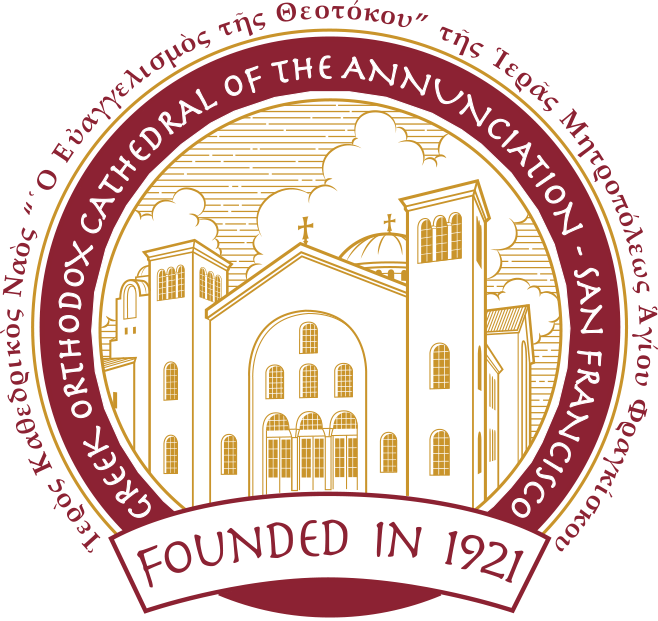The above caption refers to the opening line of the apolytikion-hymn of the Feast of the Annunciation. “Today is the fountainhead of our salvation, “ is the translation. Notice, the hymn begins with the words “Today is” rather than “Once upon a time there was.” What happened 2000 years ago—the Archangel Gabriel announced to Mary that she would become the bearer of God in the flesh—is not an event that occurred once upon a time, but, rather, an event that unveils to us, in our time and for all time, its result, which is our salvation. For, the Annunciation is not an announcement of things to come. But, once the Archangel tells Mary she will bear the Savior, through the Holy Spirit, the Son of God—the Word of God—takes on flesh, right then and there. The Annunciation IS the Incarnation.
The icon shown here was “written” by Professor George Kordis, the iconographer for the new Cathedral. Notice, we did not say it was “painted,” but “written,” as the purpose of the icon is to convey, in visual terms, the Gospel itself. Granted, the icon shown here is as stylized version of the icon of the Annunciation. The icon captures the spirit of the event which appears in the Gospel according to St. Luke, Chapter 1, verses 26-38. The angel is a non-corporeal being (notice how it is hovering above-ground, suggesting the angel is not a human being. Notice the shape of the wings, suggesting movement. Also, notice Mary, the Theotokos (meaning “God-bearer”), as she is receiving the Word. Her hands are uplifted, yet she looks downwards, in humility. The colors she wears are the colors of the cloths which covered the Ark of the Covenant (the container for the 10 Commandments). The Book of Numbers, chapter 4, verse 6 tells us: καὶ ἐπιθήσουσιν ἐπ᾽αὐτὸ κατακάλυμμα δέρμα ὑακίνθινον, καὶ έπιβάλουσιν ἐπ᾽αύτῆν ἱμάτιον ὅλον ὑακίνθυνον ἄνωθεν. “And they lay upon it a deep blue skin, and placed over it a mantle all of “hyacinth” blue. Verse 8 says it also had a cloth of κόκκινον, translated as “scarlet.” Verse 13 speaks of an ἱμάτιον ὁλοπόρφυρον, a deep purple mantle. In all, there were four coverings: the first was gold-colored linen, the second was goat hair, the third was ram’s skin dyed red, and the fourth was badger skins, or porpoise/seal skins, in either case, a deep purple. By depicting Mary in these colors, and also taking into account the Biblical readings offered during her various feasts, especially that of the Annunciation, Mary is depicted in the colors of the Ark of the Covenant: by bearing Christ, she herself becomes the Ark of the Covenant. The one Ark contains the word that God wrote on the tablets, i.e. the 10 Commandment; the other Ark contains the Word of God Itself.
March 25th, therefore, is a particularly significant holy day. Our parish, which is named for the Annunciation, celebrates big time. A luncheon, hosted by the Cathedral ladies Philopotchos, will follow the Divine Liturgy on that day. Angelo Koutoulas, who celebrates his name day on the 25th, will host a dinner to those coming to Great Vespers on the evening of the 24th, and will offer the Artoklasia (service of the breaking of the bread, recalling the 5 loaves blessed by the Lord), on Sunday. March 25th, finally, is a day dear to the Greek people. For, on that day in the year 1821, the Greek people proclaimed their independence, which they won after years of struggle. The bottom line is freedom, freedom from the grasp of the evil one, freedom from oppressors, freedom in Jesus Christ.




